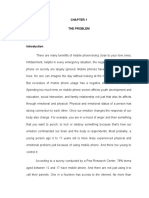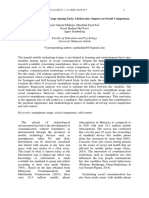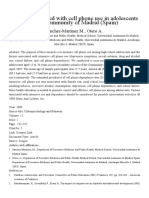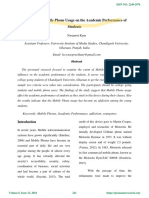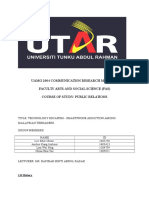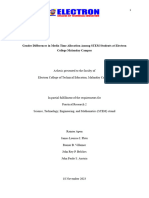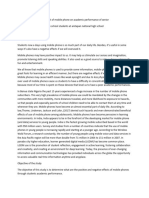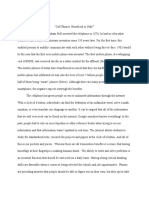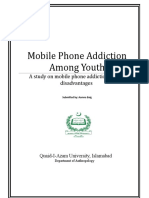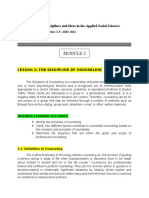TECHNOLOGY AND TEENS : MOBILE PHONE USAGE
AMONG SCHOOL ADOLESCENTS IN INDIA
Dr. R .RAMALAKSHMI,M.A., D.C.M., Ph.D.
Assistant Professor,
Department of Economics, Department of Economics
Post Graduate And Research Centre, S. T. Hindu College, Nagercoil
Introduction
Modern life has been profoundly changed by technology, and one of its most
important inventions is the mobile phone. Smartphones have become a necessary component
of everyday life for teenagers enrolled in school. These days, smartphones have many more
functions than merely making calls. These include internet access, gaming, music,
photography, and educational resources. Teenagers can connect, learn, and amuse themselves
at any time and from any location thanks to these multipurpose gadgets that work as mini-
computers. Youth in particular are becoming more and more dependent on cellphones,
spending more time on them for purposes like social networking, online education, and
multimedia consumption. Mobile phones have many advantages, such improving learning
possibilities and keeping in touch, but they can have drawbacks. Adolescents' focus, sleep,
academic performance, and in-person relationships can all suffer from excessive smartphone
use, which can result in addiction. Concern over the effects of smartphones on young people's
physical, mental, and social well-being has grown throughout the world. The purpose of this
project is to investigate how school-age adolescents use mobile phones and evaluate the
effects they have on different facets of life on a regional, national, and worldwide scale.
Developing methods to promote responsible and balanced technology use requires an
understanding of these trends.
Mobile phones have undergone a dramatic transformation over the past few decades,
evolving from bulky, call-centric devices into powerful smartphones that are now integral to
modern life. Initially introduced in India in 1995, mobile phones were expensive and mostly
limited to professionals and urban elites. The first mobile call in India was made on July 31,
1995, by West Bengal Chief Minister Jyoti Basu to Union Communications Minister Sukh
Ram. Over time, declining tariffs, free incoming calls, and affordable feature phones spurred
mass adoption, especially between 1995 and 2010. The introduction of 3G services in 2010
and the growing affordability of smartphones marked a turning point, with platforms like
Facebook, WhatsApp, and YouTube becoming immensely popular among adolescents. The
digital revolution further accelerated with the 2016 launch of Reliance Jio, which drastically
lowered data costs and expanded internet access, particularly among students during the
COVID-19 pandemic. Today, smartphones are widely used by teenagers not only for
communication but also for learning, entertainment, and social networking. However, this
digital boom has come with significant challenges. Mobile phones, once a luxury, have now
�become essential, with global mobile subscriptions equaling the global population by 2013,
and the Asia-Pacific region accounting for over half of them. While mobile penetration stands
at 96% globally, excessive usage—particularly among adolescents—has led to increased
concerns over mental health, internet addiction, and emotional well-being. Adolescents with
internet addiction often display high novelty-seeking behavior, poor emotional regulation,
depression, and social withdrawal, often within dysfunctional family environments. Since the
family plays a central role in the Indian context, family-oriented strategies are crucial to
managing digital addiction. Adolescence is a critical period for brain development, and
excessive screen exposure, coupled with negative experiences in homes, schools, or online
spaces, can increase vulnerability to mental disorders like anxiety, depression, and behavioral
issues. Alarmingly, suicide remains the third leading cause of death among individuals aged
15–29. Studies show that while screen time over two hours daily is linked to lower happiness
and increased depression, non-screen activities like sports and face-to-face interactions
enhance well-being. Smartphone overuse has also led to behaviors like “phubbing,” where
individuals ignore those physically present in favor of phone use, diminishing social
satisfaction. Globally, smartphone use among adolescents has surged, with over 95% of U.S.
teens owning one, and similar patterns observed across Europe and Asia. Countries like
China and South Korea have implemented strict digital curfews and detox programs in
schools to combat mobile addiction. In India, which now has over 900 million users, mobile
phones account for 88% of all telecom users, with rural areas contributing significantly. A
2022 Lancet Psychiatry report revealed that 40% of Indian adolescents show signs of mobile
addiction, primarily due to social media and gaming apps. The World Health Organization
has also raised concerns about the potential carcinogenic effects of mobile radiation and other
physical symptoms like fatigue and tingling, attributed to electromagnetic fields. The
widespread use of technologies like 3G, 4G, Wi-Fi, and Bluetooth has driven mobile
communication to unprecedented levels. While smartphones have enabled immense
connectivity and access to information, they also pose risks to adolescent health,
interpersonal relationships, and psychological development. Addressing smartphone
addiction and promoting healthy digital habits is now a pressing global and national priority.
Modern life has been profoundly transformed by technology, and one of its most significant
inventions is the mobile phone. For school-going adolescents, smartphones have become an
essential part of daily life. These devices now serve far beyond just making calls—they
provide internet access, gaming, music, photography, and educational tools. Functioning as
mini-computers, smartphones enable teenagers to learn, connect, and entertain themselves
anytime and anywhere. With growing dependence, youth increasingly use mobile phones for
social networking, online education, and multimedia. While mobile phones offer numerous
benefits such as improved learning and connectivity, excessive use can lead to negative
outcomes. Addiction to smartphones can affect adolescents' focus, sleep, academic
performance, and personal relationships. Globally, concerns are rising about the impact of
smartphone usage on adolescents' physical, mental, and social well-being. This study
investigates mobile phone usage patterns among school-age adolescents and examines its
effects at regional, national, and global levels.
The evolution of mobile phones has been dramatic—from bulky, call-only devices to
powerful smartphones central to modern life. Introduced in India in 1995, mobile phones
�became widespread after reduced call rates and the rise of affordable handsets. The digital
surge, especially after the 2016 Reliance Jio launch, enabled widespread internet access,
boosting smartphone use for learning and social media. However, this rise also brought
challenges like mental health concerns, addiction, and behavioral issues. Adolescents with
internet addiction often face emotional regulation difficulties, depression, and social
withdrawal, especially in dysfunctional family settings. In India, family-based strategies are
essential for managing digital overuse. With adolescence being a critical developmental
stage, excessive screen time can trigger anxiety, depression, and behavioral disorders.
Globally, smartphone overuse has led to habits like “phubbing,” reducing real-life social
satisfaction. Countries such as China and South Korea have implemented digital curfews and
detox programs. In India, where mobile users exceed 900 million, studies show nearly 40%
of adolescents show signs of addiction. The World Health Organization also warns about
mobile radiation risks. Though smartphones enhance connectivity, addressing their overuse is
now a vital global and national priority.





